Dragon Crystal
| Dragon Crystal | |
|---|---|
 | |
| Developer(s) | Sega |
| Publisher(s) | Sega |
| Platform(s) | Sega Game Gear, Sega Master System |
| Release | (Sega Master System) (Sega Game Gear) |
| Genre(s) | Roguelike |
| Mode(s) | Single player |
Dragon Crystal (Japanese: ドラゴンクリスタル ツラニの迷宮, Dragon Crystal Shirani's Maze) is a video game released for the Sega Master System and Sega Game Gear. Its gameplay derives from roguelikes, with a more intuitive graphical interface.
Story
As the player rides a bicycle late one afternoon, he turns down an alley never before noticed and enters an antique shop. There a mysterious glowing crystal lies on a shelf. Upon approaching the crystal and gazing into it, a powerful force pulls the player in, causing a blackout.
The player awakens in a forest with a large egg following behind. This forest is a huge maze, crawling with dangerous creatures. The player finds weapons and other items scattered around with which to fight monsters. The only way out of this place is to continue forward, defeating monsters and growing in power along the way.
Gameplay
The player starts off in the middle of a maze-like level covered by fog of war, and must find a way to warp to the next maze. There are thirty floors in all, each randomized using room patterns such that every game is different. A player who completes all every floor wins. Weapons, armor, potions, rings, food, money and enemies are randomly placed on the ground. If a player walks around for too long without picking up food, he will die of starvation. Money is used to revive from death, increasing in cost with the number and severity of previous deaths.
Despite appearances, the game is essentially turn-based. Each movement or action is the equivalent to one turn and both monsters and the play will take it in turn to make attacks, which means getting surrounded can be particularly dangerous as every enemy would get one attack for every one attack the player makes. Likewise, a player who wanted to take their time in thinking about what to do next in a battle could do so without being attacked by just standing still.
Items picked up in the game, with the exception of armour and weapons, are coloured coded, with colours representing an effect that cannot be discovered until the player uses an item of that colour. Once, say, a Bronze Book has been used, all future Bronze Books will be renamed to reflect their powers. Generally speaking, Pots are potions that can heal or poison the player, Books provide either maps or spells that may strengthen the player in some way or negate a harmful effect (such as removing cursed items), Rods cast spells that affect enemies and Rings provide bonuses to stats (or sometimes are cursed, such as the Hunger Ring, which makes the player consume food much more quickly and requires a Bless Book to remove). Unwanted items, such as armour or weapons weaker than the ones already worn by the player or cursed or poisonous items, can either be dropped or thrown at enemies for minor damage.
As the player equips better items, their ingame appearance changes to reflect the new gear, if it's sufficiently different - Robe, Cuirass and Leathers all have the same basic appearance, for example, while Chainmail gives the player a new look.
As the player gains levels, the egg accompanying them hatches into a dragon that grows with the player.
Enemies in the game vary quite a lot and each enemy would have something unique about it - Toads could poison the player, Fire Diamonds could make the player dizzy (which had the effect of randomisng the direction the player moved in), Ninjas teleported around the area, some Slime Blobs create copies of themselves that also attack you and so on.
Sequels
Fatal Labyrinth is another Sega roguelike, first released for Sega Meganet and later on the Mega Drive. A sequel to Dragon Crystal, entitled Dragon Crystal II, was planned for mobile phones, but never eventuated.
